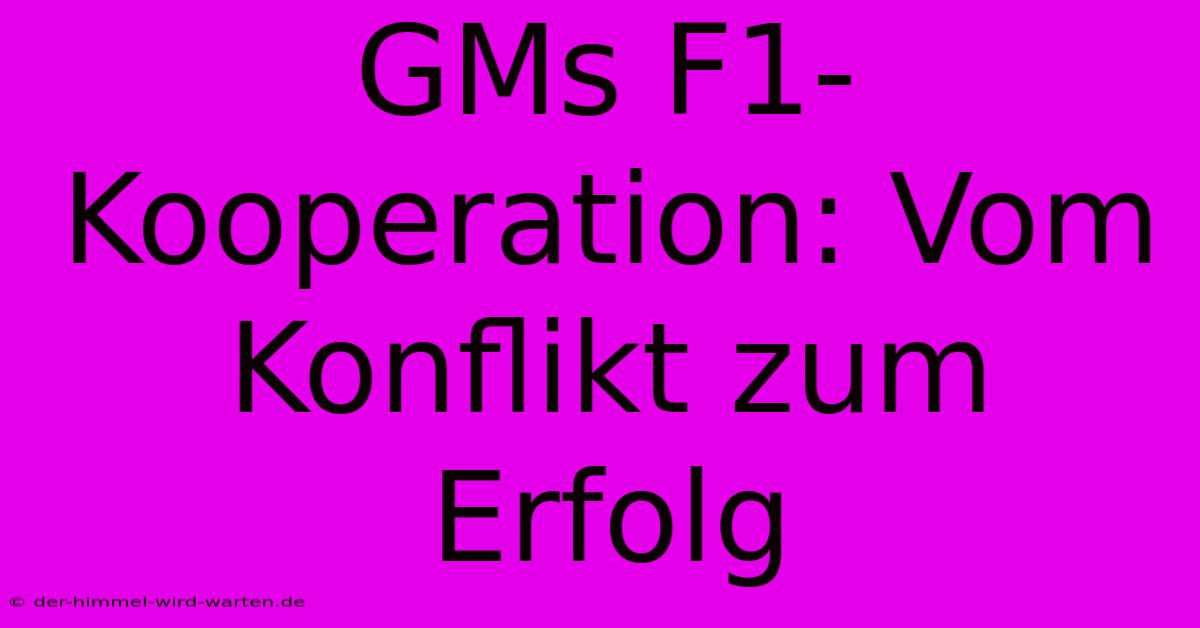GMs F1-Kooperation: Vom Konflikt Zum Erfolg

Discover more detailed and exciting information on our website. Click the link below to start your adventure: Visit Best Website GMs F1-Kooperation: Vom Konflikt Zum Erfolg. Don't miss out!
Table of Contents
GMs F1-Kooperation: Vom Konflikt zum Erfolg
Hey Leute! Let's talk about something that really got my gears grinding a few years back: GM's involvement in Formula 1. Initially, it felt like a total dumpster fire, a chaotic mess of missed opportunities and frankly, bad decisions. But, like a phoenix rising from the ashes (or maybe more like a really rusty, but ultimately functional, car), it eventually kind of worked out. This isn't a perfectly polished success story – more of a "how we learned from our mistakes" kind of tale.
The Early Days: A Recipe for Disaster?
Remember when GM first dipped its toes into F1? Oof. It was messy. I mean, really messy. They partnered with various teams, like Lotus, with varying degrees of success – mostly lack of success. It felt like they threw money at the problem without a clear strategy, kind of like buying a lottery ticket hoping to win big, but forgetting to actually check the numbers. This period taught me a valuable lesson: thorough planning is key in any partnership, especially one as complex as an F1 venture. You can't just wing it.
One specific memory stands out – an article I read about a crucial engine component failure during qualifying. Apparently, a tiny, seemingly insignificant detail had been overlooked during the design phase. It cost them dearly, both in terms of performance and reputation. This highlighted the importance of meticulous attention to detail in high-stakes engineering projects. It’s not just about the big picture; it's about the tiny screws and bolts, too.
Finding the Right Formula: Collaboration and Adaptation
GM's initial struggles weren't entirely their fault. The F1 landscape is brutal – incredibly competitive, constantly evolving, and unforgiving of errors. Their early missteps demonstrated the critical need for adaptability and flexible strategies. They needed to learn the game before they could play it.
Eventually, GM seemed to figure things out. They shifted their approach, focusing more on technology transfer and building stronger collaborative relationships with their partners. This wasn't a quick fix; it involved extensive research and development, testing, and refinement of their strategies. It's like baking a cake – you can't just dump all the ingredients together and expect a masterpiece. You need the right ingredients, the right process, and patience.
The Success (or Lack Thereof): Measuring Results
Did GM's F1 involvement ultimately succeed? That’s a complex question. While they didn’t win countless championships, they did achieve notable technological advancements. Their experience in F1 led to significant improvements in their road car engines, improving fuel efficiency and performance. This highlights the importance of setting realistic goals and measuring success beyond simple wins and losses. It’s about the long-term benefits, the technological advancements, and the lessons learned.
Maybe, from a purely financial standpoint, it wasn't a massive home run. But the experience provided invaluable data, and the lessons learned undoubtedly impacted other aspects of GM's operations. It’s a great example of how even seemingly unsuccessful ventures can yield significant returns in the long run. Think of it as an expensive, but ultimately valuable, education.
Key Takeaways for Future Partnerships
So, what did I learn from GM's F1 rollercoaster? A few things, actually:
- Strategic Planning is Paramount: Don't jump in without a well-defined strategy and realistic expectations.
- Collaboration is Key: Building strong partnerships is crucial for success in any competitive environment.
- Adaptability is Essential: The ability to adapt to changing circumstances is vital for long-term survival.
- Measure Success Holistically: Don’t focus solely on immediate, easily quantifiable results. Consider long-term benefits and technological advancements.
GM's journey in F1 is a reminder that even failures can pave the way for future success. It's a story of mistakes, learning, and adaptation. And hey, that's a story worth sharing, right?

Thank you for visiting our website wich cover about GMs F1-Kooperation: Vom Konflikt Zum Erfolg. We hope the information provided has been useful to you. Feel free to contact us if you have any questions or need further assistance. See you next time and dont miss to bookmark.
Featured Posts
-
Ulm Bombenentschaerfung In Der Nacht Geglueckt
Nov 26, 2024
-
Spieltag 5 Cl Spannende Begegnungen Erwarten Uns
Nov 26, 2024
-
Vf Aktie Investieren Lohnt Es Sich
Nov 26, 2024
-
17 Vermisste Touristenboot Im Roten Meer Gesunken
Nov 26, 2024
-
Dhl Flugzeugabsturz Vilnius Terrorverdacht
Nov 26, 2024
